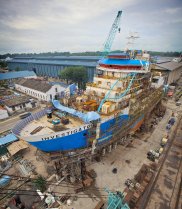Australia’s newest weather radar set to be all at sea
Investigator is a 93.9 metre purpose-built ship research vessel currently under construction and due for delivery in late 2013 as the flagship of Australia’s Marine National Facility.
The Executive Director for the Future Research Vessel Project, Toni Moate, said the 1.75 tonne weather research radar will be installed on the highest point of Investigator and will be able to collect cloud and weather data anytime, anywhere in the world’s oceans.
“The 1.75 tonne weather research radar will be installed on the highest point of Investigator and will be able to collect cloud and weather data anytime, anywhere in the world’s oceans.”
Ms Toni Moate, Executive Director, Future Research Vessel Project
“Data will be gathered from clouds towering 20 kilometres over the tropical ocean to cold ice storms in the Antarctic, in a 150 kilometre radius from the ship, and will have a broad range of research applications,” Ms Moate said.
The dual-polarisation weather radar is part of a new generation of weather technology that is being compared to the difference in television between black and white to colour technology. The greater detail provided by the state-of-the-art device will allow meteorologists to gather more information about the atmosphere than ever before, including clearly seeing the difference between rain and snow.
Australia’s scientific community has been advising on the fit out and design of Investigator since the inception of the project, providing recommendations on specialist equipment, like the weather radar, via a Technical Advisory Group.
Dr Peter May from the Bureau of Meteorology and the Centre for Australian Weather and Climate Research, together with his colleague Dr Alain Protat, are part of the Technical Advisory Group and it’s their expertise that has been central to the selection and installation of the weather research radar on the ship.
“With Investigator we will be able to source weather data from places we have previously not been able to access, such as the deep Southern, Indian, and Pacific Oceans,” said Dr May.
“This advanced radar will tell us not only how much it is raining but also the size of the drops, what mixtures of water and ice are present in the clouds, and what types of ice crystals are present.
“It will be a keystone for the study of cloud formations and contribute to improvements in numerical weather forecasting and climate prediction models over the vast areas of ocean surrounding Australia,” said Dr May
This kind of data is important to study cloud systems that represent key processes for weather and climate models. The high quality data collected from the radar will be an asset to the global weather and climate research community, from better understanding of tropical monsoons to polar cloud systems. There is a wide range of applications for the data that will be captured by this cutting edge technology.
The successful tenderer to supply the radar is Environmental Systems & Services (ES&S), which is an Australian advanced technology company specialising in solutions in environmental and allied fields such as meteorology.
The state-of-the-art research vessel Investigator will be owned and operated by CSIRO, which runs Australia’s Marine National Facility. It will replace the Facility’s 66 metre research vessel Southern Surveyor. All Australian scientists and their international collaborators can apply for time onboard the Facility to conduct marine and atmospheric research.
The Federal Government in 2009 committed A$120 million to the purchase of a new research vessel for Australia’s Marine National Facility. The project is an initiative of the Federal Government’s Super Science Initiative and financed from the Education Investment Fund.
Media resources
Click image for high resolution version



